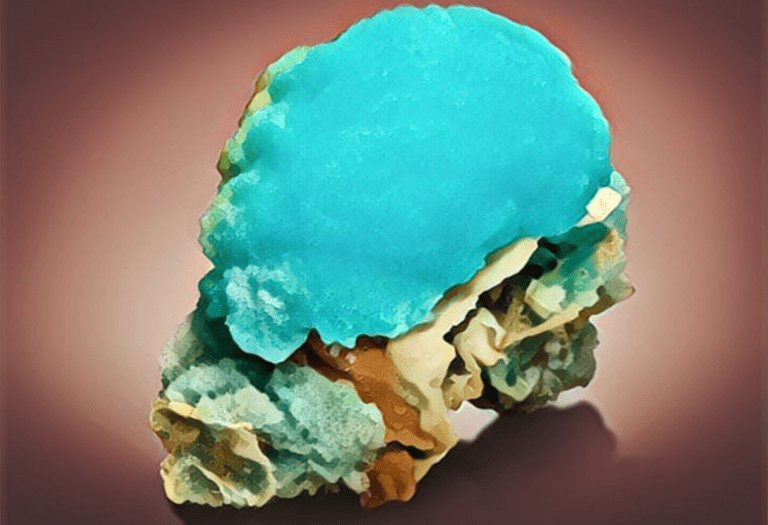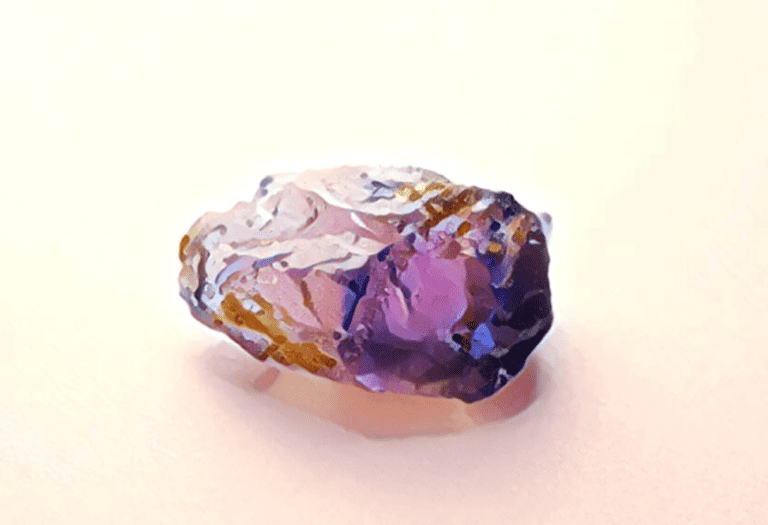Discovering the secrets of aragonite, a captivating mineral with a crystal lattice that whispers tales of Earth’s inner workings, can be a thrilling experience.
You might find yourself holding a piece that’s a direct line to the ocean’s depths or the ancient soils where it formed.
But how do you know if what you’ve got is genuine aragonite? It’s all in the details—color, form, and reaction to acid. We’ll guide you through the simple steps to identify this mineral with confidence, ensuring you can distinguish aragonite from its carbonate cousins.
Whether you’re a seasoned collector or a curious novice, understanding aragonite’s unique characteristics will enhance your appreciation for the mineral world.
Get ready to unlock the mystery and add a new gem to your collection.
To identify genuine aragonite, examine its needle-like crystals or twisted forms, typically in white, blue, green, or brown hues. Aragonite leaves a white streak, is non-magnetic, and ranks 3.5-4 on the Mohs hardness scale. It shows strong birefringence under polarized light and is translucent to opaque.
How to Identify Aragonite Through Testing
Visual Inspection
Start your identification process with a careful Visual Inspection. Aragonite typically manifests in needle-like crystals or twisted, branch-like forms. Its colors range from white or colorless to variations of blue, green, and brown. Uneven surfaces and the presence of striations are also indications of genuine aragonite. Don’t overlook transparency, as aragonite can range from translucent to opaque.
The Streak Test
Conduct a streak test to determine the powder color of aragonite. Drag your specimen across an unglazed porcelain plate, known as a streak plate, to observe the color left behind. Aragonite’s streak will usually be white, confirming its identity without altering the specimen’s appearance.
Magnet Test
The Magnet Test is a quick way to check for any magnetic properties. Aragonite is not magnetic, so if your sample responds to a magnet, it’s likely not aragonite. This test effectively rules out other iron-bearing minerals that may be confused with aragonite.
Hardness Test
For the hardness test, utilize the Mohs scale where aragonite ranks around 3.5 to 4. This means it’s more resistant to scratching than gypsum but can be scratched by materials of a higher hardness such as fluorite. Use a simple tool like a copper penny or a steel knife to gently attempt to scratch your mineral specimen.
Birefringence Test
Aragonite exhibits strong birefringence when viewed under polarized light. If you have a polarizing filter, rotate it while looking through to your sample. You should observe changes in color or brightness, indicating the birefringent nature of aragonite.
Checking The Diaphaneity
Examine the diaphaneity, or the ability of light to pass through aragonite. Depending on the specimen, light might not pass through at all, or it could provide a luminous glow around the edges. The latter is a typical characteristic of translucent minerals like aragonite.
Single or Double Refraction
Aragonite is known for its double refraction qualities, where it splits light into two distinct rays. When placing your aragonite specimen on printed text, the letters should appear doubled. This is a distinguishing feature that sets it apart from other carbonate minerals.
Refractive Index Test
If you’re equipped with a refractometer, you can measure aragonite’s refractive index. Aragonite has a refractive index between 1.530 and 1.685. These values are notably different from similar minerals, making this a reliable method to confirm your identification.
Finding The Specific Gravity
Aragonite’s specific gravity ranges between 2.93 and 2.95. You can measure this by weighing the mineral in air and then suspended in water. By computing the ratio of these weights, you can calculate the specific gravity and check it against known values for aragonite.
Identifying Aragonites in the Field
While in the field, identify aragonite formations by their distinctive crystal habits. Stalactitic, columnar, and pisolitic forms are common in aragonite-rich environments. Moreover, aragonite often forms in hot spring areas, giving you a clue about where to look.
Recognizing Potential Aragonite Rocks
When scouting for aragonite rocks, look for the signs described above — color, form, and the crystal’s response to light. Be aware of the typical environments where aragonite forms, such as sedimentary beds and volcanic rock. Familiarity with these settings can significantly increase your chances of finding genuine aragonite specimens.
Physical Characteristics of Aragonite

When you’re on the hunt for aragonite, you’ll want to be familiar with its distinct physical characteristics. Aragonite’s crystal system is orthorhombic, which means its crystals are formed with three axes of unequal length all at right angles to each other. This unique formation leads to a variety of shapes such as prismatic, needle-like, or even columnar, giving aragonite specimens a distinctive structure.
One of the most remarkable attributes of aragonite is its twinning behavior. Twinning occurs when two crystal parts grow together in a symmetrical manner, and it’s especially common in aragonite, often resulting in pseudo-hexagonal forms. You might observe this as repetitive or mirror-image patterning in the crystal.
In terms of luster, aragonite has a glassy to pearly sheen that can be quite striking when you view it under a source of light. The mineral’s transparency can range from transparent to translucent, adding to its visual appeal. As for its streak, when you scrape aragonite across a porcelain plate, it leaves a white streak.
Don’t forget about its Mohs hardness scale rating, which is between 3.5 and 4. This means it’s relatively soft and can be scratched with a knife, which is something to keep in mind during identification.
Lastly, aragonite is known for its variability in color. It can present in hues of white, brown, yellow, blue, green, or even purple. This color diversity, while beautiful, means you should consider other traits alongside color when identifying aragonite to avoid any mix-ups with other minerals.
How Are Aragonite Formed?
Aragonite forms in a variety of geological settings. Most commonly, you’ll find aragonite materializing in sedimentary environments where it precipitates from carbonate-rich waters. This mineral is especially prevalent in marine settings, making it a common component of coral reefs and shellfish.
In the depths of the ocean, aragonite forms due to the high pressure and lower temperatures, conditions that favor its stability over calcite—the other polymorph of calcium carbonate. At these depths, the calcium ions in seawater combine with carbonate ions to produce this distinctive mineral.
Aragonite is also known to form in hydrothermal vents, where superheated water, rich in dissolved minerals, interacts with cooler ocean water, causing the aragonite to precipitate rapidly. These particular conditions create the unique crystal formations associated with aragonite—twisted, elongated structures that are different from the more blocky calcite.
Aside from natural processes, aragonite can also develop through biogenic means. Many marine organisms, such as mollusks and corals, have the ability to secrete aragonite to form their hard exoskeletons and shells. The process is guided by organic matrices that control the crystallization pathway, resulting in the elaborate and diverse forms of aragonite found in nature.
Understanding these processes is crucial as it sheds light on the conditions under which aragonite can form, guiding you in identifying potentially fruitful locations for seeking out this mineral. Keep an eye out for environments that mirror these formation conditions when you’re in the field.
Preparation for Aragonite Hunting
Before embarking on your quest to find aragonite, it’s essential to be well-prepared. Having all the necessary tools and taking appropriate safety measures will not only make your hunt more productive but also ensure a safer experience.
Gathering the Right Tools
Your tool kit should be tailored to the environments where aragonite is found. Remember, effective tools are key in distinguishing aragonite from look-alikes and other minerals.
- Hand Lens or Magnifier: Essential for up-close inspection of potential aragonite specimens.
- Geologist’s Hammer and Chisel: Ideal for extracting samples from larger rock formations.
- Hardness Test Kit: Helps you perform on-site scratch tests to confirm mineral hardness.
- Portable Streak Plate: Convenient for performing streak tests in the field.
- Acid Bottle: A drop of acid can indicate aragonite if it fizzes, showing its reaction to acid.
- Safety Glasses: Protect your eyes when chipping away at rock or using acid.
- GPS Device or Maps: To help navigate potential aragonite locations.
- Sample Bags and Markers: To label and store your finds effectively.
Keep your tools in a sturdy backpack or field bag, ensuring they’re easily accessible and safely stored during transport.
Safety Considerations
Your safety should never be compromised while hunting for aragonite. Some environments where aragonite forms can be treacherous, and proper safety gear is a must.
- Wear Sturdy Footwear: Boots with a solid grip are essential, especially when traversing rocky or slippery terrain.
- Protective Clothing: Long sleeves and pants defend against sunburn and scratches from rough terrain.
- Helmet and Gloves: Protect your head and hands, especially if you are working near cliffs or within caves.
- Stay Hydrated: Bring plenty of water to prevent dehydration, particularly on hot days or in arid locations.
- First Aid Kit: Always be prepared for minor injuries.
- Inform Someone of Your Plans: Should you lose your way or have an accident, it’s vital that someone knows where to look for you.
With your tools ready and safety measures in place, you’re well on your way to fieldwork that’s not only enjoyable but yields results. Take your time to familiarize yourself with the distinctive properties of aragonite, so you can identify and collect samples confidently.
Handling and Care of Found Aragonite

Once you’ve successfully identified and collected aragonite samples, proper handling and care are crucial for preserving their natural beauty and scientific value. This section will guide you through the essential steps of cleaning and storing aragonite specimens.
Cleaning Aragonites
Aragonite’s sensitivity to acids means that you need to clean your finds carefully to avoid damaging them.
- First, remove loose debris with a soft brush.
- Rinse the specimens in distilled water to prevent any chemical reactions that could occur from tap water impurities.
- For stubborn dirt, you might want to use a mild soap solution and gently scrub with a toothbrush; just ensure you rinse the samples thoroughly afterward.
- Dry the aragonites with a soft, lint-free cloth or let them air dry on a paper towel.
Avoid using harsh chemicals or cleaners as they could etch or dull the mineral’s surface. Also, remember that prolonged exposure to water can alter aragonite, so keep cleaning sessions short.
Storing Aragonites
The proper storage of your aragonite specimens is essential to maintain their integrity over time. Here are a few guidelines to help protect your finds:
- Store each piece in an individual container or wrap them in tissue paper to prevent scratching.
- Label each sample with the location and date of find for future reference. This can be crucial for scientific study or personal cataloging.
- Keep aragonites in a cool, dry place away from direct sunlight, which can cause fading or degradation.
- If possible, maintain a stable humidity level to prevent the samples from becoming too brittle.
By following these tips, you’ll ensure your aragonite specimens remain in excellent condition for years to come. Whether for personal enjoyment, educational purposes, or scientific study, handling and caring for your aragonites with respect ensures their preservation and continued appreciation.
Conclusion: Confirming Aragonite is Real
Mastering the art of identifying aragonite is just the beginning.
With the right techniques and tools, you’re now equipped to distinguish this unique mineral from its counterparts. Remember, the care you take in handling, cleaning, and storing your specimens is crucial for their longevity. By following the guidelines provided, you’ll not only confirm your finds but also ensure they remain in pristine condition for years to come.
Embrace the journey of discovery and take pride in your growing collection.







